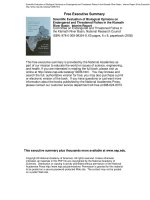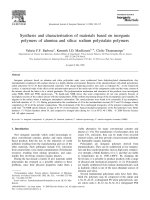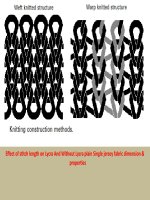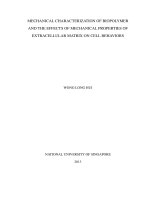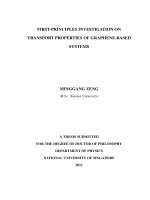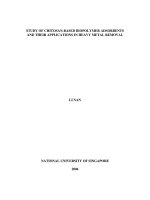Properties of nanocomposite based on sulfur and modified Ketjenblack EC-600JD carbon
Bạn đang xem bản rút gọn của tài liệu. Xem và tải ngay bản đầy đủ của tài liệu tại đây (509.76 KB, 8 trang )
TẠP CHÍ KHOA HỌC
TRƯỜNG ĐẠI HỌC SƯ PHẠM TP HỒ CHÍ MINH
HO CHI MINH CITY UNIVERSITY OF EDUCATION
JOURNAL OF SCIENCE
Tập 16, Số 9 (2019): 493-500
ISSN:
1859-3100
Vol. 16, No. 9 (2019): 493-500
Website:
Research Article*
PROPERTIES OF NANOCOMPOSITE BASED ON SULFUR
AND MODIFIED KETJENBLACK EC-600JD CARBON
Bui Thi Thao Nguyen*, Nguyen Hoang Duong, Pham Thuc Đoan,
Thai Ngoc Minh Hoang, Hoang Xuan Tung, Nguyen Nhi Tru
Faculty of Materials Technology, University of Technology - VNU HCM
Corresponding author: Bui Thi Thao Nguyen – Email:
Received: June 27, 2019; Revised: August 26, 2019; Accepted: September 23, 2019
*
ABSTRACT
This article reports on how sulfur - carbon nanocomposite was prepared by melt infiltration
method with Ketjenblack EC-600JD carbon functionalized by H2O2. The mixture of sulfur and
carbon was converted to the nanocomposite by sintering in nitrogen atmosphere at 160oC for 6
hours and 180oC for 2 hours. The nanocomposite’s weight ratio of carbon to sulfur was confirmed
by energy-dispersive X-ray spectroscopy. Structural properties and morphology of this
nanocomposite was characterized by powder X-ray diffraction, scanning electron microscopy, and
transmission electron microscopy analytical methods. The obtained nanocomposite contained 69
wt% sulfur and 31 wt% Ketjenblack EC600JD carbon which was modified by 30 wt% H2O2.
Keywords: Sulfur-carbon nanocomposite, Ketjenblack EC-600JD, hydrogen peroxide, melt
infiltration method.
1.
Introduction
Sulfur is the tenth most abundant element in the universe and exists as a component
of various minerals such as galena (PbS), gypsum (CaSO4·2(H2O), pyrite (FeS2),
sphalerite (ZnS or FeS), cinnabar (HgS), stibnite (Sb2S3), epsomite (MgSO4·7(H2O)),
celestite (SrSO4), and barite (BaSO4) (Wen et al., 2014). Thus, sulfur is low-cost and
environmentally friendly. Moreover, elemental sulfur possesses a high theoretical capacity
of 1675 mAh g−1, making it a promising cathode material for secondary batteries such as
lithium-sulfur and sodium-sulfur batteries, which are notable for their high specific energy.
However, sulfur also possesses certain drawbacks, including low conductivity and the
dissolution of intermediate products, polysulfide phases, formed by electrochemical
reaction between sulfur and anode material (Petzold et al., 2016; Suzuki et al., 2017).
Therefore, it is necessary to increase the conductivity of cathode material and reduce
Cite this article as: Bui Thi Thao Nguyen, Nguyen Hoang Duong, Pham Thuc Đoan,
Thai Ngoc Minh Hoang, Hoang Xuan Tung, & Nguyen Nhi Tru (2019). Properties of nanocomposite based
on sulfur and modified Ketjenblack EC-600JD carbon. Ho Chi Minh City University of Education Journal of
Science, 16(9), 493-500.
493
HCMUE Journal of Science
Vol. 16, No. 9 (2019): 493-500
dissolution of polysulfide by preparing composite of sulfur with conductive materials such
as carbon nanotube, porous carbon, graphene, and conductive polymer. Among these
materials, porous carbon has received the most interest due to its high conductivity and
porous structure, providing shelters for sulfur and decreasing the movement of
intermediate products into electrolyte (Bugga et al., 2017).
There have been numerous studies concerning the preparation of nanocomposite of
sulfur and carbon. Research proposal challenges were the increase of the linkage of sulfur
to conductive material and infiltration of sulfur particles into porous carbon. Elemental
sulfur could be embedded into carbon by melt infiltration, vapor phase infiltration, solution
infiltration, and mechanical intrusion. Sulfur element melts at 119.6oC and achieves the
minimum of viscosity at around 154oC (Evers & Nazar, 2012). Switching from solid to
liquid state, sulfur’s specific volume increases, and it easily diffuses into the space of
porous carbon. This technique does not require advanced equipment and can be carried out
in an inert atmosphere to avoid oxidation of sulfur. For microporous conductive host
mater����������������������������������������������������������������������������������������������������������������������������������������������������������������������������������������������������������������������������������������������������������������������������������������������������������������������������������������������������������������������������������������������������������������������������������������������������������������������������������������������������������������������������������������������������������������������������������������������������������������������������������������������������������������������������������������������������������������������������������������������������������������������������������������������������������������������������������������������������������������������������������������������������������������������������������������������������������������������������������������������������������������������������������������������������������������������������������������������������������������������������������������������������������������������������������������������������������������������������������������������������������������������������������������������������������������������������������������������������������������������������������������������������������������������������������������������������������������������������������������������������������������������������������������������������������������������������������������������������������������������������������������������������������������������������������������������������������������������������������������������������������������������������������������������������������������������������������������������������������������������������������������������������������������������������������������������������������������������������������������������������������������������������������������������������������������������������������������������������������������������������������������������������������������������������������������������������������������������������������������������������������������������������������������������������������������������������������������������������������������������������������������������������������������������������������������������������������������������������������������������������������������������������������������������������������������������������������������������������������������������������������������������������������������������������������������������������������������������������������������������������������������������������������������������������������������������������������������������������������������������������������������������������������������������������������������������������������������������������������������������������������������������������������������������������������������������������������������������������������������������������������������������������������������������������������������������������������������������������������������������������������������������������������������������������������������������������������������������������������������������������������������������������������������������������������������������������������������������������������������������������������������������������������������������������������������������������������������������������������������������������������������������������������������������������������������������������������������������������������������������������������������������������������������������������������������������������������������������������������������������������������������������������������������������������������������������������������������������������������������������������������������������������������������������������������������������������������������������������������������������������������������������������������������������������������������������������������������������������������������������������������������3.
Results and discussion
3.1. Properties of ketjenblack carbon oxidized by hydroperoxide
The modified Ketjenblack carbon’s properties were examined by FTIR. The FITR
spectra of pristine Ketjenblack carbon (CB00 sample) and modified Ketjenblack (CB60
sample) are presented in the Figure 1. In the FTIR spectroscopy, the peak at 3422.75 cm-1
shows the O-H stretching mode of hydroxyl functional groups. The band at 1570.98 cm-1 is
assigned to the C=O stretching vibration of carboxyl groups. An intense band at 1160.10 cm-1
reflects the C-O stretching and O-H bending modes of polar functional groups. The FTIR
spectrum of CB60 sample presents the functional groups which are attached on carbon surface.
In contrast, there is no peak in the FTIR spectrum of CB00. The existence of 3422.75 cm-1,
1570.98 cm-1, and 1160.10 cm-1 peaks proves that after oxidation by H2O2, there are various
hydroxyl and carboxyl groups appearing in Ketjenblack carbon samples.
495
HCMUE Journal of Science
Vol. 16, No. 9 (2019): 493-500
Fig. 1. FTIR spectra of modified Ketjenblack carbon
The Raman spectra of Ketjenblack carbon are shown in Figure 2. The intensity ratio
of D-band and G-band of Raman spectra determines the impurity and defect concentration
of the carbon. G-band indicates the graphite structure and D-band presents the formation of
defects in the structures. Therefore, the high ID/IG ratio confirms that carbon sample
possesses a high number of defects, proving its strongly oxidized surface. The ID/IG ratios
of pristine Ketjenblack carbon (CB00) and modified Ketjenblack carbon (CB60) are 1.108
and 1.226, respectively (Fig. 2 and Table 1). These results reflect that the surface of CB60
is oxidized by H2O2. Therefore, CB60 was used for the next experiment of fabrication of
nanocomposite.
Fig. 2. Raman spectra of modified Ketjenblack carbon
Table 1. Intensity ratios of D-band and G-band of Raman spectra of modified Ketjenblack carbon
Sample
ID
IG
ID/IG
3246.99
2932.98
1.108
CB00
4693.76
3829.28
1.226
CB60
496
HCMUE Journal of Science
Bui Thi Thao Nguyen et al.
3.2. Structure of the sulfur-carbon nanocomposite
Fig. 3. XRD patterns of sulfur (S), modified carbon (CB60),
sulfur-carbon nanocomposite (SC)
The XRD patterns of sulfur, modified carbon, and sulfur-carbon nanocomposite are
illustrated in Fig. 3. Sulfur presents typical orthorhombic crystal structure with strong
diffraction peaks at 2θ=23–29°, while CB60 carbon shows amorphous structure with two
broad diffraction peaks at 24° and 45°. The XRD pattern of SC exhibits a similarity
compared with the patterns of CB60 and sulfur, containing the peaks at 2θ=23–29° and the
broad peak appearing at 24° with weaker intensity. The existence of these peaks proves
that the SC nanocomposite contains modified carbon and sulfur.
3.3. Surface morphology and elemental distribution of the sulfur-carbon
nanocomposite
Fig. 4. SEM images of SCB (a), SC (b) and EDS mapping of SC
497
HCMUE Journal of Science
Vol. 16, No. 9 (2019): 493-500
The morphologies and particle size of sulfur-carbon nanocomposite are described by
SEM images (Fig. 4). The nanocomposites samples are labelled SC. SCB is named for the
nanocomposite before being heated. SEM image (Fig. 4a) of SCB shows that the carbon and
sulfur are distributed uniformly with a loose-particle aggregation and narrow particle size at
about 50 to 100 nm. This image is different from that of SC (Fig. 4b) which are the
nanocomposites being heated. Through melt infiltration, sulfur element diffuses and disperses
in the porous structure of carbon, increasing the linkage of composite components and
aggregation of carbon and sulfur particles. The elemental distribution of carbon and sulfur in
the sulfur-carbon nanocomposite is illustrated in Fig. 4 (c, d, e). It can be seen that the carbon
and sulfur elements are uniformly distributed and dispersed in the nanocomposite.
Fig. 5. TEM images of SC
The microstructure of the sulfur-carbon nanocomposite is revealed by TEM images
which are shown in Fig. 5. It can be seen that the composite consists of carbon and sulfur,
and sulfur element corresponds to the darker area in the image. It is apparent that sulfur
particles are partially covered by the carbon layer which can be seen in Fig. 5b.
Fig.6. EDS spectrum of the sulfur-carbon nanocomposite
The content of the nanocomposite is presented by EDS spectrum (Fig. 6). It can be
observed that the contents of carbon and sulfur are about 31 wt% and 69 wt%,
respectively.
498
HCMUE Journal of Science
Bui Thi Thao Nguyen et al.
4.
Conclusions
In this research, the sulfur-carbon nanocomposite based on sulfur and modified carbon
was successfully fabricated with a composition of 69 wt% sulfur and 31 wt% modified
Ketjenblack EC600JD carbon by melt infiltration method. The process of modifying carbon
was conducted by oxidation of 30 wt% H2O2 for 1 hour. The FTIR and Raman spectrum of
modified carbon revealed that it possessed polar functional groups grafting on the surface
carbon. The properties of the carbon sulfur nanocomposite were examined by XRD, SEM,
TEM, EDS. Through these methods, the structure, morphology, and composition of the
nanocomposite were confirmed that the nanocomposite contained nano-sized sulfur and
carbon particles and sulfur particle was partially enveloped by carbon.
Conflict of Interest: Authors have no conflict of interest to declare.
Aknowledgment: This research is funded by Ho Chi Minh City University of Technology
– VNU-HCM under grant number T-CNVL-2018-14.
REFERENCES
Bugga, R. V., Jones, S. C., Pasalic, J., Seu, C. S., Jones, J. P., & Torres L. (2017). Metal SulfideBlended Sulfur Cathode in High Energy Lithium-Sulfur Cells. J Electrochem. Soc. 164(2),
A265-267.
Elazari, R., Salitra, G., Garsuch, A., Panchenko, A., & Aurbach, D. (2011). Sulfur-Impregnated
Activated Carbon Fiber Cloth as a Binder-Free Cathode for Rechargeable Li-S Batteries.
Adv. Mater, 23, 5641.
Evers, S., & Nazar, L. F. (2012). Graphene-enveloped sulfur in a one pot reaction: a cathode with
good coulombic efficiency and high practical sulfur content. Chem. Commun., 48, 1233.
Fu, Y. Z., & Manthiram, A. (2012). Core-shell structured sulfur-polypyrrole compositecathodes for
lithium-sulfur batteries. RSC Adv., 2, 5927.
Petzold, A., Juhl, A., Scholz, J., Ufer, B., Goerigk, G., Fröba, M., Ballauff, M., & Mascotto, S.
(2016). Distribution of Sulfur in Carbon/Sulfur Nanocomposites Analyzed by Small-Angle
X-ray Scattering. Langmuir, 32(11), 2780-2786.
Su, Y. S., & Manthiram A. (2012). A facile in situ sulfur deposition route to obtain carbon-wrapped
sulfur composite cathodes for lithium-sulfur batteries. Electrochimica Acta, 77, 272.
Suzuki, K., Tateishi, M., Nagao, M., Imade, Y., Yokoi, T., Hirayama, M., Tatsumi, T.,
& Kanno, R. (2017). Synthesis, Structure, and Electrochemical Properties of a Sulfur-Carbon
Replica Composite Electrode for All-Solid-State Li-Sulfur Batteries. J. Electrochem. Soc.,
164(1), A6178-A6183.
Wang, H. L., Yang, Y., Liang, Y. Y., Robinson, J. T., Li, Y. G., Jackson, A., Cui, Y., & Dai, H. J.
(2011). Graphene-Wrapped Sulfur Particles as a Rechargeable Lithium-Sulfur Battery
Cathode Material with High Capacity and Cycling Stability. Nano Lett., 11, 2644.
Wen, Z. S., Lu, D., Li, S., Sun, J. C., Ji, & S. J. (2014). Fabrication and Electrochemical
Performance of Sulfur/Carbon Composite Synthesized from Self-Assembled Phenol Resin.
Int. J. Electrochem. Sci., 9(1), 1-11.
499
HCMUE Journal of Science
Vol. 16, No. 9 (2019): 493-500
KHẢO SÁT TÍNH CHẤT CỦA NANOCOMPOSITE ĐƯỢC CHẾ TẠO TỪ LƯU HUỲNH
VÀ CACBON KETJENBLACK EC-600JD BIẾN TÍNH
Bùi Thị Thảo Nguyên*, Nguyễn Hoàng Dương, Phạm Thục Đoan,
Thái Ngọc Minh Hoàng, Hoàng Xuân Tùng, Nguyễn Nhị Trự
Khoa Công nghệ Vật liệu – Trường Đại học Bách khoa – ĐHQG TPHCM
*
Tác giả liên hệ: Bùi Thị Thảo Nguyên – Email:
Ngày nhận bài: 27-6-2019; ngày nhận bài sửa: 26-8-2018; ngày duyệt đăng: 23-9-2019
TÓM TẮT
Trong bài báo này, tác giả đã chế tạo nanocomposite lưu huỳnh – cacbon bằng phương
pháp nóng chảy từ cacbon Ketjenblack EC-600JD đã được chức hóa bằng hydrogen peroxide. Quá
trình hỗn hợp lưu huỳnh và cacbon chuyển sang dạng nanocomposite được thực hiện bằng phương
pháp gia nhiệt ở nhiệt độ 160oC trong 6h và 180oC trong 2h ở môi trường khí nitơ. Tỉ lệ khối lượng
thành phần cacbon và lưu huỳnh trong nanocomposite được xác định bằng phổ tán xạ năng lượng
tia X. Tính chất, cấu trúc và hình thái bề mặt của nanocomposite được phân tích bằng phương
pháp nhiễu xạ tia X, kính hiển vi điện tử quét và kính hiển vi điện tử truyền qua. Kết quả nhận được
nanocomposite chứa 69 % lưu huỳnh và 31 % Ketjenblack EC-600JD đã được biến tính bằng dung
dịch H2O2 30 %.
Từ khóa: Nanocomposite lưu huỳnh – cacbon, Ketjenblack EC-600JD, hydrogen peroxide,
phương pháp nóng chảy.
500
